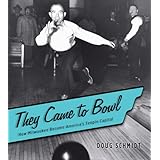
Average Reviews:

(More customer reviews)It will surprise virtually no one with a Wisconsin background to learn that Milwaukee played a key role in the rise of bowling as a popular recreation. Assisted by a strong German heritage and a love of drinking beer outside the home, Milwaukee took to recreational bowling like few others. It was, relatively speaking, an immediate hit. Beginning around the turn of the century, lanes quickly began popping up - first a few lanes in a few pubs, then several lanes in multipurpose recreation complexes. As the sport became more popular, systematic governance became necessary and Milwaukee supplied many of the important pioneering leaders - serving as the headquarters for some of bowling's most important organizations. Probably even more importantly, Milwaukee supplied more than its share of great bowlers during the sport's heyday. Like everywhere else, bowling declined in popularity in Milwaukee as the millennium drew to its close. No longer were local bowling programs sufficiently profitable, nor were seventy lane bowling centers of much use. Yet bowling remains a significant part of Milwaukee's past and continuing culture. Thanks in large part to the prominence it gave Milwaukee when bowling was king.
Doug Schmidt admirably recounts the history of bowling in Milwaukee, principally by introducing the reader to the places, people and personalities that led the way. The stories run the gamut - from tiny basements with two lanes to giant bowling centers with scores of lanes, from quiet and careful businessmen to live-fast, die-young shooting stars. The story probably isn't entirely coherent. Nor will everyone find great interest here - indeed, I struggled through portions where the author highlighted seemingly endless game and series scores. But, Mr. Schmidt successfully retrieves the lost glory of one of Milwaukee's truly glorious pasts. For a time Milwaukee was very nearly the center of the world as far as bowling was concerned, and for an even greater period of time one could not speak of top rank bowling without considering Milwaukee. Mr. Schmidt shows why that was so and tells us who was responsible. Perhaps, this isn't the most important history, but it is fun and it's a piece of the puzzle.
Click Here to see more reviews about: They Came to Bowl: How Milwaukee Became America's Tenpin Capital
A frozen rope. A urethane split on the drives. Chicken tracks on the telescore.* Do you know your bowling lingo? You will along with much more when you read They Came to Bowl: How Milwaukee Became America's Tenpin Capital. From the thrill of the perfect strike to the agony of a ball gone astray, anyone who has rolled a ball down the lanes will find themselves or someone they know in the people, places and stories covered in this book.
In this authoritative and lively book, Doug Schmidt traces bowling's roots from a German religious rite centuries ago to the sport that made Milwaukee famous. From the taverns and saloons that housed recreational games to the sell-out crowds and million-dollar beer sponsorships of televised tournaments, this well-illustrated book covers both sport and city, charting the changing face of bowling over the century. Packed with memorable showdowns and improbable heroes, They Came to Bowl will take you back to the changing lanes of bowling in Milwaukee — and the sport as a whole.
* frozen rope=a ball rolled with excessive speed almost straight to the pocket; urethane split=2-8-10 or 3-7-9 split caused by sharp breaking point of reactive resin balls; drives=alleys; chicken tracks=string of strikes

No comments:
Post a Comment